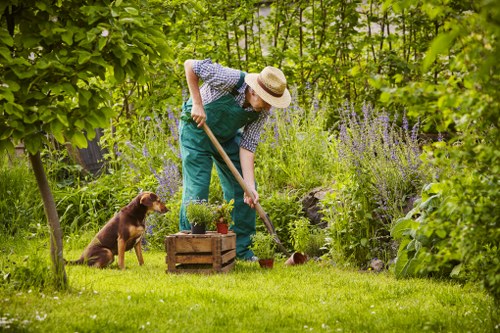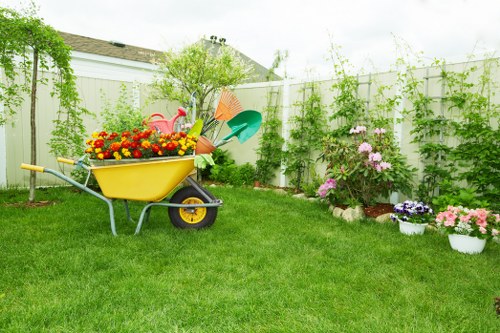Garden Maintenance in Lawn Mowing
Importance of Lawn Mowing in Garden Maintenance

Maintaining a lush, green lawn is a key component of overall garden maintenance. Regular lawn mowing serves not only an aesthetic purpose but also plays a crucial role in the health and vitality of your grass. By keeping your lawn mowed, you encourage even growth, prevent the spread of weeds, and enhance the overall appearance of your garden.
Proper lawn mowing can significantly impact the ecosystem of your garden. It helps in maintaining the balance between grass growth and environmental factors, ensuring that your lawn remains resilient against pests and diseases. Regular mowing also contributes to improving soil health by preventing overgrowth, which can lead to thatch buildup and other issues.
Incorporating lawn mowing into your garden maintenance routine is essential for creating a welcoming outdoor space. Whether you have a small backyard or an expansive garden, consistent mowing practices will help you achieve a well-manicured and attractive lawn.
Best Practices for Effective Lawn Mowing

Achieving an effectively mowed lawn involves adhering to several best practices. Following a structured mowing schedule is the first step towards maintaining a healthy lawn. Depending on the grass type and climate, mowing frequency may vary, but generally, once a week is recommended during peak growing seasons.
Adjusting the mowing height based on the season can also enhance lawn health. During warmer months, keeping the grass slightly longer helps retain moisture and shade the soil, while in cooler seasons, lowering the mower height can prevent fungal growth and other issues.
Another critical aspect is using sharp mower blades. Dull blades tear the grass, causing it to become frayed and vulnerable to diseases. Regularly sharpening mower blades ensures clean cuts, promoting healthy and vigorous grass growth.
Tools and Equipment for Lawn Mowing

Investing in the right tools and equipment is vital for efficient lawn mowing. A quality lawn mower, whether it's a reel mower, a rotary mower, or a commercial-grade machine, provides the foundation for effective grass cutting. Consider the size of your lawn and the type of grass when selecting a mower to ensure optimal performance.
Add-ons such as mulching kits, grass collectors, and adjustable handles enhance the functionality and comfort of your mowing experience. Additionally, regular maintenance of your equipment, including cleaning and servicing, prolongs its lifespan and ensures consistent performance.
Personal protective equipment (PPE) like gloves, safety glasses, and sturdy footwear are also essential to safeguard against potential injuries while mowing. By equipping yourself with the right tools and taking necessary precautions, you can make lawn mowing a safer and more enjoyable task.
Seasonal Lawn Maintenance Tips

Adapting your lawn mowing practices to the changing seasons is crucial for maintaining a healthy garden year-round. In spring, focus on removing debris and prepping your lawn for the growing season. Mow regularly to encourage dense grass growth and prevent weeds from taking hold.
During summer, adjust your mowing height to accommodate heat and drought conditions, keeping the grass slightly longer to retain moisture. It's also essential to mow during cooler parts of the day to prevent stress on the grass.
In fall, reduce mowing frequency as grass growth slows down and prepare your lawn for the winter months. Aeration, overseeding, and fertilization are key activities that complement mowing, ensuring your lawn remains robust and ready for the next growing season.
Common Lawn Mowing Mistakes to Avoid

Avoiding common mistakes in lawn mowing can significantly improve the health and appearance of your lawn. One frequent error is cutting the grass too short, which can weaken the grass and make it more susceptible to weeds, pests, and diseases. Always follow the one-third rule: never remove more than one-third of the grass blade in a single mowing session.
Another mistake is neglecting mower maintenance. Failing to clean and sharpen your mower regularly leads to uneven cuts and stresses the grass. Ensure your mower is in good working condition to provide clean and precise mowing.
Mowing when the grass is wet is also discouraged as it can result in clumping, uneven cuts, and increased susceptibility to fungal infections. Wait until the grass is dry before mowing to achieve the best results and maintain overall lawn health.
Implementing a Sustainable Lawn Mowing Routine

Creating a sustainable lawn mowing routine involves balancing aesthetics with environmental considerations. Implementing eco-friendly practices such as mulching, using electric mowers, and reducing water usage contributes to a greener garden.
Mulching mowers recycle grass clippings back into the lawn, providing natural fertilizer and reducing the need for chemical inputs. Switching to electric or manual mowers minimizes carbon emissions and noise pollution, promoting a healthier environment for both your garden and the surrounding ecosystem.
Incorporating water-efficient watering techniques, such as drip irrigation and rainwater harvesting, complements your mowing routine by ensuring the grass receives the necessary moisture without excessive water usage. These sustainable practices not only enhance lawn health but also promote responsible garden stewardship.
Enhancing Lawn Health Through Proper Mowing

Proper mowing techniques are fundamental to maintaining a healthy lawn. Regular mowing encourages even growth and prevents the grass from becoming overgrown and stressed. It's important to mow at the recommended height for your specific grass type to promote optimal growth patterns and resilience.
In addition to adjusting mowing height, ensuring that you mow in different directions each time helps prevent the grass from leaning and growing unevenly. This practice also reduces soil compaction and promotes better air circulation around the grass blades.
Fertilizing your lawn in conjunction with proper mowing further supports grass health by providing essential nutrients. A well-fertilized lawn is more robust, able to withstand environmental stresses, and less prone to weed invasion.
Integrating Lawn Mowing with Other Garden Maintenance Tasks

Integrating lawn mowing with other garden maintenance tasks creates a cohesive and efficient gardening routine. Combining mowing with activities such as weeding, fertilizing, and pest control ensures that all aspects of lawn care are addressed in tandem.
For instance, mowing before fertilizing allows the nutrients to reach the soil more effectively, enhancing absorption and utilization by the grass roots. Similarly, mowing after watering can help distribute moisture evenly and prepare the lawn for other maintenance tasks.
Establishing a comprehensive maintenance schedule that includes mowing and complementary tasks promotes a healthier and more vibrant garden, reducing the need for intensive interventions and fostering sustainable lawn care practices.
Choosing the Right Grass Type for Easier Lawn Maintenance

Selecting the appropriate grass type for your region and lawn conditions can simplify maintenance and enhance lawn resilience. Different grass species have varying requirements for mowing, watering, and sunlight, making it essential to choose a type that aligns with your gardening goals and environmental factors.
Cool-season grasses, such as Kentucky bluegrass and fescue, thrive in temperate climates and require regular mowing and fertilization to maintain their lush appearance. Warm-season grasses, like Bermuda and Zoysia, are more drought-tolerant and generally need less frequent mowing, making them suitable for warmer regions.
Understanding the characteristics of your chosen grass type ensures that your mowing and maintenance practices are tailored to support its growth, resulting in a healthier and more attractive lawn.
Advanced Lawn Mowing Techniques for Professional Results

Adopting advanced lawn mowing techniques can elevate the quality of your lawn maintenance to professional levels. Practices such as strip mowing, topdressing, and edging contribute to a refined and polished lawn appearance.
Strip mowing involves alternating the mowing direction each time you mow, creating a stripe pattern that enhances the visual appeal of your lawn. Topdressing, the application of a thin layer of compost or soil, helps improve soil structure, promotes healthy grass growth, and reduces compaction.
Edging around garden beds, pathways, and other landscape features provides a clean boundary, giving your lawn a neat and organized look. These advanced techniques require attention to detail and consistency but result in a well-maintained and visually stunning garden.
Maintenance Schedule Recommendations

Establishing a consistent maintenance schedule is crucial for effective lawn mowing. Regular mowing intervals, coupled with seasonal adjustments, ensure that your lawn remains healthy and well-groomed throughout the year.
- Weekly Mowing: During peak growing seasons, mow your lawn once a week to maintain optimal grass height and prevent overgrowth.
- Bi-weekly Mowing: In slower growth periods, reduce mowing frequency to every two weeks, adjusting as needed based on grass growth.
- Seasonal Adjustments: Modify your mowing schedule to align with seasonal changes, such as increasing frequency in spring and autumn.
Adhering to a structured schedule not only promotes consistent grass health but also simplifies lawn maintenance by integrating mowing into your regular garden care routine.
Eco-Friendly Lawn Mowing Practices

Embracing eco-friendly lawn mowing practices contributes to environmental sustainability and fosters a healthier garden ecosystem. Implementing strategies such as mulching, using electric mowers, and conserving water minimizes your ecological footprint and promotes responsible lawn care.
- Mulching: Recycle grass clippings back into the lawn to provide natural nutrients and reduce the need for chemical fertilizers.
- Electric Mowers: Opt for electric or manual mowers to decrease carbon emissions and reduce noise pollution.
- Water Conservation: Water your lawn during the early morning or late evening to minimize evaporation and avoid overwatering.
Incorporating these eco-friendly practices not only benefits the environment but also enhances the overall health and resilience of your lawn.
Safety Tips for Lawn Mowing

Prioritizing safety during lawn mowing is essential to prevent accidents and ensure a secure gardening environment. Implementing the following safety tips can help protect you and enhance your mowing experience.
- Wear Protective Gear: Use gloves, safety glasses, and sturdy footwear to safeguard against potential injuries from flying debris or mower contact.
- Inspect Equipment: Before each use, check your lawn mower for any damage or issues, ensuring that all parts are functioning correctly.
- Clear the Area: Remove any stones, sticks, or other objects from your lawn to prevent them from being thrown by the mower.
- Maintain Focus: Avoid distractions and stay attentive while mowing to react promptly to any unforeseen circumstances.
Following these safety measures fosters a secure and efficient lawn mowing process, allowing you to enjoy your garden with peace of mind.
Choosing the Right Time to Mow Your Lawn

Timing your lawn mowing activities appropriately can enhance the efficiency and effectiveness of your maintenance routine. Mowing at the optimal time of day and under suitable weather conditions ensures the best results for your lawn.
- Time of Day: Mow during the cooler parts of the day, such as early morning or late afternoon, to prevent stress on the grass and minimize heat-related damage.
- Weather Conditions: Avoid mowing when the grass is wet, as it can lead to clumping and uneven cuts. Additionally, mowing during dry periods reduces the risk of fungal infections.
- Growth Patterns: Monitor your lawn's growth and adjust mowing times accordingly to maintain consistent grass height and health.
Strategically timing your mowing sessions aligns with natural grass growth cycles, promoting a greener and more resilient lawn.
Conclusion

Effective garden maintenance in lawn mowing is a blend of consistent practices, proper techniques, and mindful consideration of environmental factors. By adhering to best practices, investing in the right tools, and embracing sustainable methods, you can cultivate a healthy and attractive lawn that elevates the beauty of your garden.
Whether you're a seasoned gardener or a novice, implementing the strategies outlined in this guide will help you achieve a well-maintained lawn that serves as the centerpiece of your outdoor space. Remember to prioritize safety, embrace eco-friendly practices, and stay committed to regular maintenance to enjoy a vibrant and enduring garden.
Contact us today to learn more about our professional lawn mowing services and take the first step towards a pristine and flourishing garden.